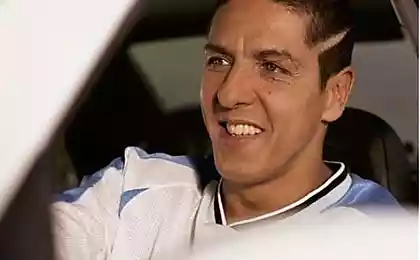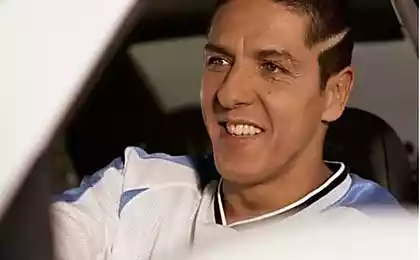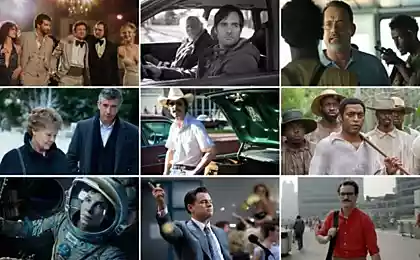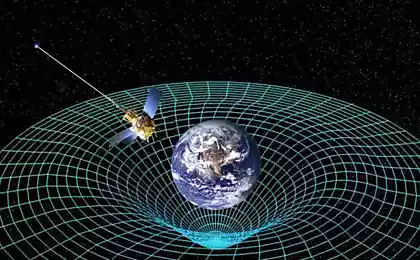1704
"Gravity". Reality and fiction
Alfonso Cuarón acclaimed film "Gravity" is perhaps the most successful attempt in cinema show space for what it is. On the significance of it can be compared with the movie "Space Odyssey" by Stanley Kubrick. I suggest you transfer an interview with this seasoned astronaut, who will talk about that because in the film, and that could not have happened in reality, as well as some other details about the stay in space.

Professional astronaut checks the facts from the film "Gravity»
In science fiction, thousands of variants of descriptions of life in outer space, but "Gravity" - a rare film in which an attempt to reflect reality. Due to space travel Alfonso Cuaron You seem to find yourself in one of those famous color photographs NASA (who now can not see because of the Congress!) In the best astronauts in history. Everything in the film, except for the presence of Sandra Bullock and George Clooney, immediately striking realism. Therefore, immediately raises the question: "What is this true and what is fiction?" yesterday Astrophysicist Neil DeGress Tyson tried to answer some of these questions on Twitter, and taking into account the limitations 140 characters, he did a fine job. Still, we thought to check the facts in the film more thoroughly able man, who was in space.

Former astronaut Scott Parazynski United States made seven of space travel, including a seven-hour dangling from the robotic arm during the repair of solar panels on the International Space Station, during which he could die at any time from electric shock. He had to watch as each solar cell was broken to pieces by subject "Gravity." Except this point, the film he liked. In wordsmiths astronaut was a long, hard talk about space debris, jetpacks, tears in space and laundry Sandra Bullock.
Did you like the film? Are there any post-traumatic stress?
In fact, I'm a little bored at home, while he was in space! From stay in outer space and a beautiful flight over the hurricane on the planet jaw-dropping, and even a 3-D does not convey the full effect of the flight above the Earth. There are some great meaning to "go there." This is the best job in the world. Sometimes you fall asleep while working at the computer, and then suddenly you see a hurricane or the Himalayas, and feel how lucky you are. I love it.
Sandra Bullock says she likes the silence of space. How quiet it really?
Being in a spacesuit, you hear very soothing sounds. Usually it is the rotation of the fan, which provides your life activity, surpassing the oxygen of the suit. You also hear the crackle of the radio. So check out the link. If your suit is not no sound, it is very, very bad day. Therefore, we do not like when the suit "is silent." But wake up in space - it is extraordinarily beautiful; I just would not say that there quietly.
How soon you have noticed in the film something and said, "Wait, this can not be»?
Immediately alerted that there are three people in space, only one of them doing the work. Poor Sandra performed all the work, while the other two were just having fun guy nearby.
One of them was hanging on the ropes in the cargo bay of the shuttle in the gym, and Clooney, running around on the turbo PMA. PMA - a manned maneuvering unit that was used long ago to fly on the program "Space Shuttle". You could never fly as did the character of George Clooney. He was flying in the vicinity of the telescope "Hubble". If you had to do it, you have stumbled on the solar panels, bent them and maybe put out of action. It's all fiction [Laughs.]. PMA is working on a very precise technology, but its speed is much less than for many reasons. When you fly to orbit the Earth, moves at a speed of 28,164 kilometers per hour and feel the effect of the orbital mechanical effects, which include both the Earth and the spacecraft in which you are traveling. In fact, George flight is much more complicated than might be assumed.
You said that existing technology does not allow the distance between space stations. How far apart are located, for example, "Hubble" and "The International Space Station»?
It is also strongly evident. Indeed, the "Hubble" is in its orbit, "International Space Station" - on their own and "Chinese Space Station" - on their own. If you do not go into the details of orbital mechanics, flight or apparatus of different satellite systems in orbit, they are very far apart. Orbit "Hubble" is very close to the equatorial ... it looks like the central zone, only at very high altitude, about 644 km above the earth. The orbit of the International Space Station is strongly tilted, so it takes a breadth of Kazakhstan to the equivalent in the southern hemisphere. Issued firebreak more earth. Worst of all, they are very distant from each other, moving at different altitudes and at different rates, so between them there is a fixed distance. They both bullet velocity with respect to each other. Their orbits intersect at different times during the day, so it is physically impossible to get from one place to another.
In fact, if you were in space on the "Hubble» -
Then you're out of luck [Laughs.]
When George Clooney orbiting spacecraft, it is testing a new technology "jetpack". Do you think that if he could not be tied to the fact?
No. Well, if you fly via a manned maneuvering unit to grab the moon, yes. In fact, we did this in the past three or four times during the program "Shuttle" and made forays into space at a distance of several hundred steps to show the ability of the flight. In the first case, we really captured satellite and returned it back into orbit. But it's a pretty small distances. In other cases, we were bound to spacecraft with a steel braided cable to twist the drum. If you release the cable - it is unwound, but once approaching the ship, it is wound back. So we have always adhered to the main ship carrier, whatever it is: the robotic arm, "Shuttle" or the "International Space Station».
What did you think about how the astronauts move in space?
They made it look like a gymnastic exercise on the horse when you need to hold on to huge seizures. But if you look at an experienced astronaut in space, it is very graceful, even beautiful. If you are used to the costume, you will be able to overcome the center of gravity of the suit, it would look almost easy. Of course, it takes effort, but if smoothly control their moment of inertia, you can not just move in space, and change the position of your body as you like. And then do not need to constantly tighten and adjust the position. What did they do in the film, is a kind of throws or attacks. It's kind of combat suit, what we call the "elephant in a china shop." Beginners we learn to avoid such behavior and instead move smoothly, using the necessary force. We say, look before you leap - cut once. [if you're going to pitch your feet up, so you're going to want to bring your feet forward.]
This will require a certain strength. If you have submitted the motion in a given direction, it is then necessary to extinguish. That is, once you have shifted your body, you need to make a counter force to stabilize the new position where you want to stay. And all this must be done deliberately. When moving in a suit, loaded tools, weight of your body and things in knapsack, his weight is about 286 kilograms. If you are going to move abruptly and thoughtlessly, then you get tired very quickly.

Let's talk about the plausibility of the character of Sandra Bullock. It was assumed that she was very inexperienced. She said that trained six months, was on his first mission, and it could never successfully landed in the simulator. Could actually sent on such a mission as an inexperienced person?
No, but it was invented for the stories and Sandra looked very plausible [Laughs.]. Well, she called herself an expert mission, but it could be what we call "research engineer": someone who arrived on the ship later with a very narrow range of skills to perform a specific task or experiment. I believe that in order to go into space, you need at least a couple of years of training, for the acquisition of at least basic skills. So we will never send engineers and researchers in the open space. People who commit a spacewalk, like me, were mission specialists - professional astronauts. We have a lot of work in the program, including those engaged in science. Engineers, researchers arrived at a particular experiment (which was fine), but never went into space. Before you go out into space, to learn all about the space suit system and how its systems work behind the spaceship - a huge amount of training. Yes, and by research engineer nobody expects ability to land simulator. Such people come on board only to perform a certain task, and probably only once.
In the beginning, she says she feels sick. Is it normal for the first flight?
Yes, about 40% of those who for the first time in flight, the Space Adaptation Syndrome experiences, we call it the SKA, or space motion sickness. We have good drugs on board of her, but it usually takes a couple of days of the flight. And we never go into space the first four days of flight for this reason. So it would be very unusual to experience motion sickness behind the spacecraft. In fact, it would be scared to lose the cookies eaten during a walk in space. In addition, you can deprive of sight and other stuff. Without going into details, except to say that the surface tension is the dominant force up there, so it may turn out that the glass of the helmet would be a whole bunch of things you do not want to be in his space suit, and it is already prevent you to get back to the airlock chamber.
I was wondering if you throw up, then all of this will just float in the helmet?
Yes, that's exactly what will happen. All this really stick to the helmet, because the surface tension there is stronger and the "visor" ... it will be impossible to clean. There was one mission "Apollo" "Apollo 9" when one of the astronauts suffered from quite severe seasickness that canceled spacewalk.
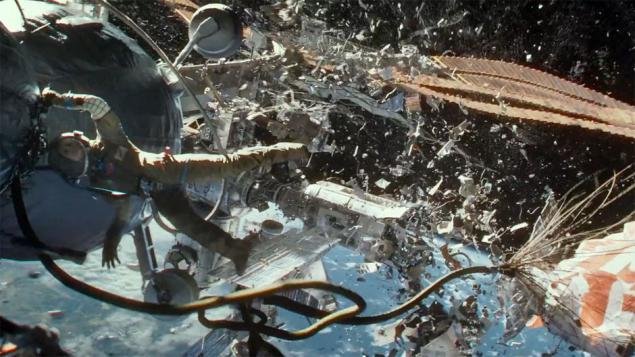
Do you experience with space debris? If you are in an open space that you see around you?
Well, firstly, if you see it, it was too late. The chain of events that led to the beginning of the destruction of the world of telecommunications, was pretty incredible, as for me. If there was a cloud of orbital debris micrometeoroids, it would be approached at a rate of tens of thousands of miles per hour. I do not know if you've seen ever shot, flying straight at you. I hope not, but if I have seen, it is not said that it is not very long. And there was a cloud much smaller fragments, which is approaching at a speed of perhaps twenty times the speed of sound. You would never have seen it. It would just burst through everything in its path. It would be a Doomsday scenario for the man in the open space.
The astronaut, who hit by shrapnel, was a huge gaping hole in the helmet. If this really happened, I would suffer an astronaut?
Frankly, I think it would be somewhat incredible. The kinetic energy of orbital debris is phenomenal and could just turn into heat. I think as soon as the waste is in contact with 100% oxygen environment inside the suit, there will be fire. You would see a lot of sparks, and everything inside the suit would turn into ashes. Such a scenario is appalling.
But such a scenario never happened, though?
Never. But we are faced with a variety of orbital debris. In fact, after all the flights on the shuttle, which we flew, the windows were dents, as well as on the casing of the shuttle. I have personally seen the damage from debris when flying to the radiator panel. I was at the top of the space station, a large code fragment passed through the panel. It looked like a bullet, shot her. At this point remained bent tabs of metal in the form of a spiral. Most likely, it was just starting the washer motor or something that crossed the path of the station. These things have an incredible energy. Even a drop of ink on such rates can have a devastating impact on human in outer space.
We see a lot of scripts with a bad end in the film. George Clooney untie themselves from a member of his team and literally floating away into space. Are you prepared in training for such scenarios? Or a situation not seen?
Actually, I do not understand what the problem is. Sandra foot got stuck in the ropes of the parachute, and she holds the hand of George. I think that all he had to do - is to crawl to her and tightened the rope to the space station. Or just push strongly that he could swim to the space station. There could not act any force that would have continued to push him. So for me it is physically impossible.
When George let go of her hand, if it happened in this space, you could drop it?
He would just swim there.
It would be less dramatic.
Yes. [Laughs.] But back to your original question, when Ed White made the first American to walk in open space (in 1965), was a real risk that he will not be able to get back to his ship "Gemini." And, in my opinion, Jim McDevitt, who was the commander of the mission, was in the event of problems with the return of Ed close the door and send it to the four winds. From this point of view, you need to save all that is possible in the mission. But we have since such a threat is no longer encountered. We knew that we could come back at Me back to the airlock. The program of the "Shuttle" we have had the luxury - the opportunity to command the shuttle undock and grab us. Another true thing in the film: every 90 minutes, you return to the same storage point in the sky. So if you're behind the shuttle or station, then 90 minutes later, you can go back into the same point and cling to, in theory, if you have enough oxygen.

The film was a terrible moment when a character turns Sadra and can not stop. What would you do in this situation?
We have a device SEYFER [SAFER]; is an acronym of the real helper for salvation in the open space [Simplified Aid for EVA Rescue]. So we have included this system manual of the controller like Nintendo and launched maneuverable jet engine - it's a real parachute, mini-ACA. It would have stabilized our position. Then we would be able to see where we are with respect to the space station and safe to fly back.
Using a fire extinguisher as the jetpack was a good or bad idea?
It does not work so well, as shown; back to Ed White, who was like a small gun that allowed him to make jet engines and fly in space. It is very difficult to control the engine about your center of mass. Therefore, it is as if the rears in space because of the inability to direct the engine in the direction opposite to the movement. But from a physical point of view, all she did was right. Although it was difficult, and the flight.
What happens when you cry in space?
Tears will not roll you eyes and flow in the face - they will accumulate in the eyes of a large drop, as in the movie "Flubber." In this case the predominant surface tension. Although fiction, tears running down the face of Sandra, looked very impressive.
What do you think of the episode, where she makes an emergency landing on Earth in a Chinese space station?
It looks spectacular, but it is unlikely. When you start to enter the upper atmosphere, we call it "input interaction" at an altitude of 120 km above the Earth. It turned out that the station in this episode was much higher and probably it could not break down as quickly. It was very dramatic, as she tried to hold on, "the Chinese space station", as Brumby.

Professional astronaut checks the facts from the film "Gravity»
In science fiction, thousands of variants of descriptions of life in outer space, but "Gravity" - a rare film in which an attempt to reflect reality. Due to space travel Alfonso Cuaron You seem to find yourself in one of those famous color photographs NASA (who now can not see because of the Congress!) In the best astronauts in history. Everything in the film, except for the presence of Sandra Bullock and George Clooney, immediately striking realism. Therefore, immediately raises the question: "What is this true and what is fiction?" yesterday Astrophysicist Neil DeGress Tyson tried to answer some of these questions on Twitter, and taking into account the limitations 140 characters, he did a fine job. Still, we thought to check the facts in the film more thoroughly able man, who was in space.

Former astronaut Scott Parazynski United States made seven of space travel, including a seven-hour dangling from the robotic arm during the repair of solar panels on the International Space Station, during which he could die at any time from electric shock. He had to watch as each solar cell was broken to pieces by subject "Gravity." Except this point, the film he liked. In wordsmiths astronaut was a long, hard talk about space debris, jetpacks, tears in space and laundry Sandra Bullock.
Did you like the film? Are there any post-traumatic stress?
In fact, I'm a little bored at home, while he was in space! From stay in outer space and a beautiful flight over the hurricane on the planet jaw-dropping, and even a 3-D does not convey the full effect of the flight above the Earth. There are some great meaning to "go there." This is the best job in the world. Sometimes you fall asleep while working at the computer, and then suddenly you see a hurricane or the Himalayas, and feel how lucky you are. I love it.
Sandra Bullock says she likes the silence of space. How quiet it really?
Being in a spacesuit, you hear very soothing sounds. Usually it is the rotation of the fan, which provides your life activity, surpassing the oxygen of the suit. You also hear the crackle of the radio. So check out the link. If your suit is not no sound, it is very, very bad day. Therefore, we do not like when the suit "is silent." But wake up in space - it is extraordinarily beautiful; I just would not say that there quietly.
How soon you have noticed in the film something and said, "Wait, this can not be»?
Immediately alerted that there are three people in space, only one of them doing the work. Poor Sandra performed all the work, while the other two were just having fun guy nearby.
One of them was hanging on the ropes in the cargo bay of the shuttle in the gym, and Clooney, running around on the turbo PMA. PMA - a manned maneuvering unit that was used long ago to fly on the program "Space Shuttle". You could never fly as did the character of George Clooney. He was flying in the vicinity of the telescope "Hubble". If you had to do it, you have stumbled on the solar panels, bent them and maybe put out of action. It's all fiction [Laughs.]. PMA is working on a very precise technology, but its speed is much less than for many reasons. When you fly to orbit the Earth, moves at a speed of 28,164 kilometers per hour and feel the effect of the orbital mechanical effects, which include both the Earth and the spacecraft in which you are traveling. In fact, George flight is much more complicated than might be assumed.
You said that existing technology does not allow the distance between space stations. How far apart are located, for example, "Hubble" and "The International Space Station»?
It is also strongly evident. Indeed, the "Hubble" is in its orbit, "International Space Station" - on their own and "Chinese Space Station" - on their own. If you do not go into the details of orbital mechanics, flight or apparatus of different satellite systems in orbit, they are very far apart. Orbit "Hubble" is very close to the equatorial ... it looks like the central zone, only at very high altitude, about 644 km above the earth. The orbit of the International Space Station is strongly tilted, so it takes a breadth of Kazakhstan to the equivalent in the southern hemisphere. Issued firebreak more earth. Worst of all, they are very distant from each other, moving at different altitudes and at different rates, so between them there is a fixed distance. They both bullet velocity with respect to each other. Their orbits intersect at different times during the day, so it is physically impossible to get from one place to another.
In fact, if you were in space on the "Hubble» -
Then you're out of luck [Laughs.]
When George Clooney orbiting spacecraft, it is testing a new technology "jetpack". Do you think that if he could not be tied to the fact?
No. Well, if you fly via a manned maneuvering unit to grab the moon, yes. In fact, we did this in the past three or four times during the program "Shuttle" and made forays into space at a distance of several hundred steps to show the ability of the flight. In the first case, we really captured satellite and returned it back into orbit. But it's a pretty small distances. In other cases, we were bound to spacecraft with a steel braided cable to twist the drum. If you release the cable - it is unwound, but once approaching the ship, it is wound back. So we have always adhered to the main ship carrier, whatever it is: the robotic arm, "Shuttle" or the "International Space Station».
What did you think about how the astronauts move in space?
They made it look like a gymnastic exercise on the horse when you need to hold on to huge seizures. But if you look at an experienced astronaut in space, it is very graceful, even beautiful. If you are used to the costume, you will be able to overcome the center of gravity of the suit, it would look almost easy. Of course, it takes effort, but if smoothly control their moment of inertia, you can not just move in space, and change the position of your body as you like. And then do not need to constantly tighten and adjust the position. What did they do in the film, is a kind of throws or attacks. It's kind of combat suit, what we call the "elephant in a china shop." Beginners we learn to avoid such behavior and instead move smoothly, using the necessary force. We say, look before you leap - cut once. [if you're going to pitch your feet up, so you're going to want to bring your feet forward.]
This will require a certain strength. If you have submitted the motion in a given direction, it is then necessary to extinguish. That is, once you have shifted your body, you need to make a counter force to stabilize the new position where you want to stay. And all this must be done deliberately. When moving in a suit, loaded tools, weight of your body and things in knapsack, his weight is about 286 kilograms. If you are going to move abruptly and thoughtlessly, then you get tired very quickly.

Let's talk about the plausibility of the character of Sandra Bullock. It was assumed that she was very inexperienced. She said that trained six months, was on his first mission, and it could never successfully landed in the simulator. Could actually sent on such a mission as an inexperienced person?
No, but it was invented for the stories and Sandra looked very plausible [Laughs.]. Well, she called herself an expert mission, but it could be what we call "research engineer": someone who arrived on the ship later with a very narrow range of skills to perform a specific task or experiment. I believe that in order to go into space, you need at least a couple of years of training, for the acquisition of at least basic skills. So we will never send engineers and researchers in the open space. People who commit a spacewalk, like me, were mission specialists - professional astronauts. We have a lot of work in the program, including those engaged in science. Engineers, researchers arrived at a particular experiment (which was fine), but never went into space. Before you go out into space, to learn all about the space suit system and how its systems work behind the spaceship - a huge amount of training. Yes, and by research engineer nobody expects ability to land simulator. Such people come on board only to perform a certain task, and probably only once.
In the beginning, she says she feels sick. Is it normal for the first flight?
Yes, about 40% of those who for the first time in flight, the Space Adaptation Syndrome experiences, we call it the SKA, or space motion sickness. We have good drugs on board of her, but it usually takes a couple of days of the flight. And we never go into space the first four days of flight for this reason. So it would be very unusual to experience motion sickness behind the spacecraft. In fact, it would be scared to lose the cookies eaten during a walk in space. In addition, you can deprive of sight and other stuff. Without going into details, except to say that the surface tension is the dominant force up there, so it may turn out that the glass of the helmet would be a whole bunch of things you do not want to be in his space suit, and it is already prevent you to get back to the airlock chamber.
I was wondering if you throw up, then all of this will just float in the helmet?
Yes, that's exactly what will happen. All this really stick to the helmet, because the surface tension there is stronger and the "visor" ... it will be impossible to clean. There was one mission "Apollo" "Apollo 9" when one of the astronauts suffered from quite severe seasickness that canceled spacewalk.

Do you experience with space debris? If you are in an open space that you see around you?
Well, firstly, if you see it, it was too late. The chain of events that led to the beginning of the destruction of the world of telecommunications, was pretty incredible, as for me. If there was a cloud of orbital debris micrometeoroids, it would be approached at a rate of tens of thousands of miles per hour. I do not know if you've seen ever shot, flying straight at you. I hope not, but if I have seen, it is not said that it is not very long. And there was a cloud much smaller fragments, which is approaching at a speed of perhaps twenty times the speed of sound. You would never have seen it. It would just burst through everything in its path. It would be a Doomsday scenario for the man in the open space.
The astronaut, who hit by shrapnel, was a huge gaping hole in the helmet. If this really happened, I would suffer an astronaut?
Frankly, I think it would be somewhat incredible. The kinetic energy of orbital debris is phenomenal and could just turn into heat. I think as soon as the waste is in contact with 100% oxygen environment inside the suit, there will be fire. You would see a lot of sparks, and everything inside the suit would turn into ashes. Such a scenario is appalling.
But such a scenario never happened, though?
Never. But we are faced with a variety of orbital debris. In fact, after all the flights on the shuttle, which we flew, the windows were dents, as well as on the casing of the shuttle. I have personally seen the damage from debris when flying to the radiator panel. I was at the top of the space station, a large code fragment passed through the panel. It looked like a bullet, shot her. At this point remained bent tabs of metal in the form of a spiral. Most likely, it was just starting the washer motor or something that crossed the path of the station. These things have an incredible energy. Even a drop of ink on such rates can have a devastating impact on human in outer space.
We see a lot of scripts with a bad end in the film. George Clooney untie themselves from a member of his team and literally floating away into space. Are you prepared in training for such scenarios? Or a situation not seen?
Actually, I do not understand what the problem is. Sandra foot got stuck in the ropes of the parachute, and she holds the hand of George. I think that all he had to do - is to crawl to her and tightened the rope to the space station. Or just push strongly that he could swim to the space station. There could not act any force that would have continued to push him. So for me it is physically impossible.
When George let go of her hand, if it happened in this space, you could drop it?
He would just swim there.
It would be less dramatic.
Yes. [Laughs.] But back to your original question, when Ed White made the first American to walk in open space (in 1965), was a real risk that he will not be able to get back to his ship "Gemini." And, in my opinion, Jim McDevitt, who was the commander of the mission, was in the event of problems with the return of Ed close the door and send it to the four winds. From this point of view, you need to save all that is possible in the mission. But we have since such a threat is no longer encountered. We knew that we could come back at Me back to the airlock. The program of the "Shuttle" we have had the luxury - the opportunity to command the shuttle undock and grab us. Another true thing in the film: every 90 minutes, you return to the same storage point in the sky. So if you're behind the shuttle or station, then 90 minutes later, you can go back into the same point and cling to, in theory, if you have enough oxygen.

The film was a terrible moment when a character turns Sadra and can not stop. What would you do in this situation?
We have a device SEYFER [SAFER]; is an acronym of the real helper for salvation in the open space [Simplified Aid for EVA Rescue]. So we have included this system manual of the controller like Nintendo and launched maneuverable jet engine - it's a real parachute, mini-ACA. It would have stabilized our position. Then we would be able to see where we are with respect to the space station and safe to fly back.
Using a fire extinguisher as the jetpack was a good or bad idea?
It does not work so well, as shown; back to Ed White, who was like a small gun that allowed him to make jet engines and fly in space. It is very difficult to control the engine about your center of mass. Therefore, it is as if the rears in space because of the inability to direct the engine in the direction opposite to the movement. But from a physical point of view, all she did was right. Although it was difficult, and the flight.
What happens when you cry in space?
Tears will not roll you eyes and flow in the face - they will accumulate in the eyes of a large drop, as in the movie "Flubber." In this case the predominant surface tension. Although fiction, tears running down the face of Sandra, looked very impressive.
What do you think of the episode, where she makes an emergency landing on Earth in a Chinese space station?
It looks spectacular, but it is unlikely. When you start to enter the upper atmosphere, we call it "input interaction" at an altitude of 120 km above the Earth. It turned out that the station in this episode was much higher and probably it could not break down as quickly. It was very dramatic, as she tried to hold on, "the Chinese space station", as Brumby.










